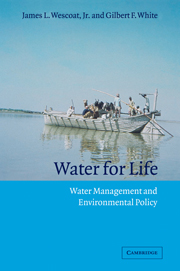Book contents
- Frontmatter
- Contents
- List of figures
- List of tables
- Preface
- List of abbreviations
- Conversions of selected units of hydrologic measurement
- 1 Water and Life
- 2 Challenge and opportunity
- 3 Unfolding recognition of ecosystem change
- 4 Natural waters
- 5 Plant–soil–water–ecosystem relationships
- 6 Groundwater
- 7 Lakes and wetlands
- 8 River channels and floodplains
- 9 Impounded rivers and reservoirs
- 10 Domestic and industrial water management
- 11 Decision processes
- 12 Integrative approaches
- Appendix: Guide to Internet resources on water and environment
- References
- Index
Appendix: Guide to Internet resources on water and environment
Published online by Cambridge University Press: 05 October 2013
- Frontmatter
- Contents
- List of figures
- List of tables
- Preface
- List of abbreviations
- Conversions of selected units of hydrologic measurement
- 1 Water and Life
- 2 Challenge and opportunity
- 3 Unfolding recognition of ecosystem change
- 4 Natural waters
- 5 Plant–soil–water–ecosystem relationships
- 6 Groundwater
- 7 Lakes and wetlands
- 8 River channels and floodplains
- 9 Impounded rivers and reservoirs
- 10 Domestic and industrial water management
- 11 Decision processes
- 12 Integrative approaches
- Appendix: Guide to Internet resources on water and environment
- References
- Index
Summary
The information revolution in the late twentieth century transformed the procedures to compile, analyze, and distribute environmental information on the availability and quality of water. In the mid twentieth century, hydrologic and water use records were increasingly archived on computer tapes for use by an expanding range of water scientists and agencies. By the 1990s, however, new Internet technologies merged to create the World Wide Web. This pivotal development vastly increased the amount of information available electronically, as well as the ease of access and extent and sophistication of public information use. At the time of this publication, the types of electronic information being made available include:
water and environmental organization websites, which describe the organization's aims, programs, publications, and calendar of activities;
electronic portal and links pages, which provide connections to hundreds of related web pages, which in turn facilitate contact and information exchange via electronic mail (email);
websites and file transfer protocol (ftp) sites that archive climatic data, hydrologic data, water quality data, water rights records, and water use records;
remote sensing websites, which compile satellite images and air photos of water and related environmental phenomena;
geographic information system (GIS) websites, which contain base maps, map layers, and interactive mapping tools;
legal and regulatory websites, which facilitate complex searching of court cases, regulations, and treaties;
websites that release real-time weather, water and environmental data, animations, and video images;
project and university websites, which compile many of the types of information above on specialized topics, e.g., wetlands restoration, ecological sanitation, glaciology, and environmental engineering;
general and specialized library catalogs, which enable searching of and, to some extent, borrowing from remote libraries around the world;
[…]
Information
- Type
- Chapter
- Information
- Water for LifeWater Management and Environmental Policy, pp. 262 - 296Publisher: Cambridge University PressPrint publication year: 2003
